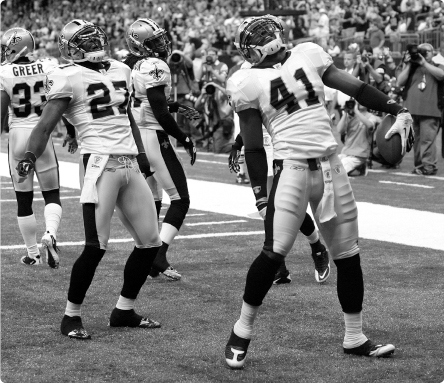Conveying Meanings

This photo was taken immediately after New Orleans Saints defenders Roman Harper and Malcolm Jenkins made a game-winning tackle during their 2011 season. Their eye-catching victory dance communicated their joy and excitement with no words at all.
© Andrew Boyd/The Times-Picayune
Just as we use words to signify unique meanings, we often use nonverbal communication to directly convey meanings. Your boss flips you a thumbs-up gesture following a presentation, and you know she means “Good job!” A friend makes a two-finger “V” at a campus rally, and you recognize it as an emblem for peace.
At other times we use nonverbal communication more indirectly, as a means for accenting or augmenting verbal communication meanings (Malandro & Barker, 1983). We do this in five ways, the first of which is by reiterating. Nonverbal communication is used to reiterate or repeat verbal messages, as when you say “Up!” and then point upward. Second, we contradict our verbal messages with our nonverbal communication. For example, a friend may ask if you’re angry, but you respond by scowling and angrily shouting “No, I’m not angry!” Third, we use nonverbal communication to enhance the meaning of verbal messages, such as when you tell an intimate “I love you” while smiling and offering a gentle touch to emphasize the point. Fourth, we sometimes use nonverbal communication to replace verbal expressions—such as when you shake your head instead of saying “no.” Finally, we use nonverbal communication to spotlight certain parts of verbal messages, such as when you increase the loudness of just one word: “STOP hitting your brother with that light saber!”
At times we use nonverbal communication more indirectly, as a means for accenting or augmenting verbal communication meanings.